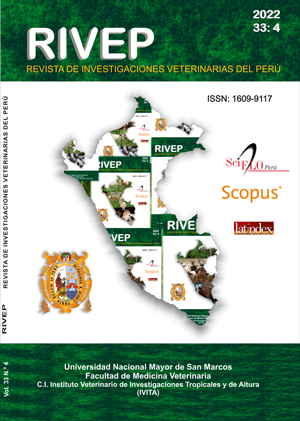Effect of breed, time of day and hair characteristics on heart and respiratory rate, and rectal and skin temperature in cattle in comfort zone
DOI:
https://doi.org/10.15381/rivep.v33i4.21804Keywords:
livestock, environment, fur, physiological response, vital signsAbstract
The study aimed to evaluate the effect of breed, time of day and mean hair density (MHDen) on heart rate (HR), respiratory rate (RR), skin temperature (ST°), rectal temperature (RT°) and difference RT°-ST°. The study included 10 heifers (4 Holstein and 6 Creoles) between 14 and 18 months of age, raised on grazing and with an average environmental temperature (ET°) of 17.6 °C and an average relative humidity (RH°) of 60.5%. A wearable vital signs monitor was used to monitor HR, RR, and ST°. Measurements were made in the morning, afternoon and evening. The evaluation of MHDen was performed using the FIBER DEN device and the mean hair diameter (MHD) with the FIBER EC device. To evaluate the effect of breed, time of day and MHDen on HR, RR, RT° and ST°, an additive linear model with two covariates (ET° and RH°) was applied. Duncan's test was used for multiple comparisons, and Pearson's correlations were calculated to evaluate relationships between variables. The HR, RR, ST° and the difference RT°-ST° were 70.1±6.8 bpm, 23.6±7.2 rpm, 31.65±1.35 °C and 7.2±1.5 °C, respectively, without differences by breed or time of day. Breed had no effect on RR and RT°, but in the morning and afternoon the animals had higher RR than in the evening, as well as with respect to the difference RT°-ST°. It is concluded that, under the conditions of the study, ET°, time of day and HR have an effect on RT°, ST° and the RT°-ST° gradient, although this effect decreases when the MHD is low.
Downloads
Downloads
Published
Issue
Section
License
Copyright (c) 2022 Adolfo Guillermo Poma Gutiérrez, René Antonio Hinojosa Benavides, Edgar Carlos Quispe Peña

This work is licensed under a Creative Commons Attribution 4.0 International License.
AUTHORS RETAIN THEIR RIGHTS:
a. Authors retain their trade mark rights and patent, and also on any process or procedure described in the article.
b. Authors retain their right to share, copy, distribute, perform and publicly communicate their article (eg, to place their article in an institutional repository or publish it in a book), with an acknowledgment of its initial publication in the Revista de Investigaciones Veterinarias del Perú (RIVEP).
c. Authors retain theirs right to make a subsequent publication of their work, to use the article or any part thereof (eg a compilation of his papers, lecture notes, thesis, or a book), always indicating the source of publication (the originator of the work, journal, volume, number and date).



